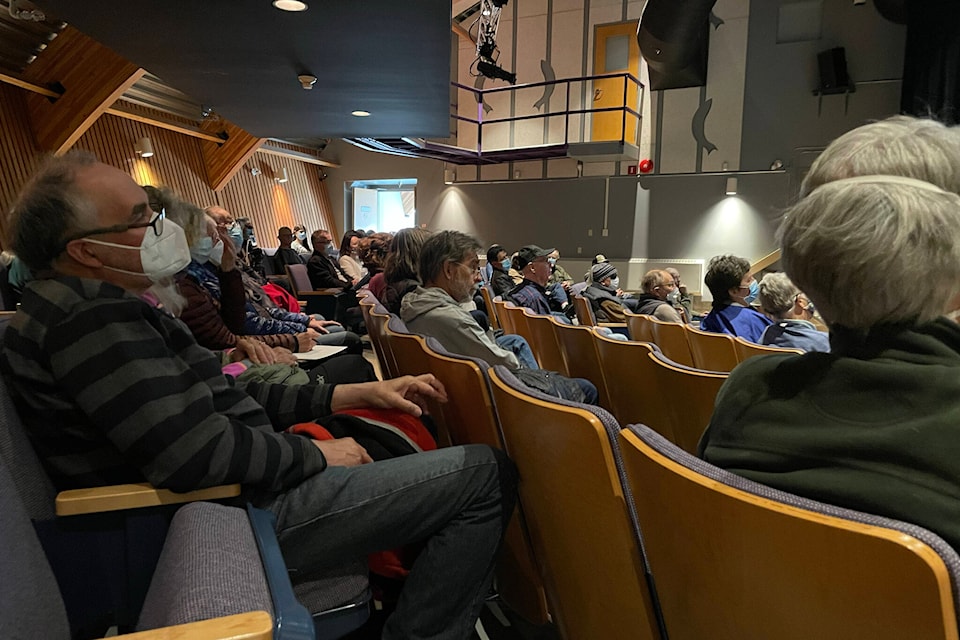May 2 was the first in-person gathering of Yukoners Concerned in nearly three years, and the Beringia theatre was nearly full. Abundantly dotted with gray-haired heads, people came to hear about heap-leaching — the mining process which is coming to dominate the Yukon’s mining landscape.
The gathering was spearheaded by Don Roberts, former politician, school principal and Yukoners Concerned organizer.
Yukoners Concerned came together in 2013 to resist fracking in the territory. Its advocacy, and the participation of hundreds of Yukoners making presentations to an all-party legislative committee, ended efforts to approve fracking in the Yukon.
“Our objective has always been to protect our water,” Roberts said in an introduction on May 2.
The organization fears the long-term consequences of heap-leaching processes to the Yukon’s fragile ecosystem of creeks, rivers and groundwater pathways.
The Beringia presentation was led by Dr. Gilles Wendling, an expert in watershed protection. Hailing from the corporate world, he now works with First Nations and environmental law groups to help protect watersheds. His trip expenses were paid for by the group, but he is volunteering his time as he travels to three more Yukon communities this week.
Like many in the audience, Wendling has grandchildren and as he said afterwards to the News, having grandchildren drives his work and concern for the planet.
On the morning of May 2, he addressed members of the Yukon Water Board; that evening he spoke to the crowd at Beringia.
The Brewery Creek mine south of Dawson City was the territory’s first experience with heap-leach processing. Cheaper than building industrial mills, heap-leaching relies on a series of ponds distributed over broad swaths of land to process and sort mineral-laden liquids. Because it requires a “lot of land” rather than an industrial mill, it creates a situation where a corporations’ costs are less and profits are realized over a shorter period of time.
Wendling described it as building “big piles of metal-rich ore you spray with cyanide-rich liquids that infiltrate, and seep into the heaps and mobilize the metal. The gold gets into this liquid, and it becomes what’s called the pregnant solution. The pregnant solution is collected and then treated in order to get the metal out. Lots of space is needed for this process.
“If you were in downtown Toronto, the mining companies wouldn’t do that. Right here, space is cheap, right. So, they can do this type of process.”
Brewery Creek was approved in 1995 and operated for five years between 1996 and 2001. All the rules, regulations and standards were followed. The mine changed hands just before closure and clean-up. By almost all accounts it was a well-run operation and a well-executed closure. The site was re-tested in 2011 and all looked good.
In 2020, the Yukon government’s water resources branch returned to the site and tested different surface and groundwater locations. This time, the findings were not so good. At some locations, contaminants exceeded federal Ministry of Environment guidelines by surprising amounts.
Several times during his talk, Wendling circled back to the problem of complexity – predicting and measuring toxicity as well as predicting groundwater flows and connections to underwater streams and rivers.
“The problem with toxicity and water quality — it’s very complex, it’s very expensive. It takes time,” Wendling said.
Wendling observed how the public is expected to be assured by the science presented in project proposals.
“You have to trust the proponent and the consultants, or you need to have a similar tool and you do it yourself. And then you can start comparing,” he said. “The software is very expensive. The data that you put in is expensive.”
He said that one of the problems with the whole review process is that it is so very difficult to receive a second or third opinion.
The public, the nearby communities, and even First Nation governments do not have access to the resources that would be needed to create a comparative data set. The public has to rely on the scenarios predicted by the companies. And then he pointed out, by example, how a company’s predictions can change, even within the same proposal.
The planned Coffee Gold mine is a huge undertaking. It still requires a water license. The location for the cyanide-laced “pregnant solution” is 1.5 kilometres long and the site is 3.5 km from the Yukon River.
Brewery Creek processed approximately 2 million tonnes of mineralized materials over its lifespan. The Coffee Gold project anticipates processing 69 million tonnes.
The Casino copper and gold project, set to be built on claims close to Coffee Gold, is even larger. Presentations on Western Copper and Gold’s website (April 2022) anticipate that 240 million tonnes of heap leach mineralized materials will be processed over 33 years at the nearby Casino location.
Wendling says complexity and cumulative effects “are a big factor in our lack of knowledge.”
This story was updated May 6 to correct that the Casino mine project will process 240 million tonnes of mineralized materials, not 240 tons.
Contact Lawrie Crawford at lawrie.crawford@yukon-news.com
